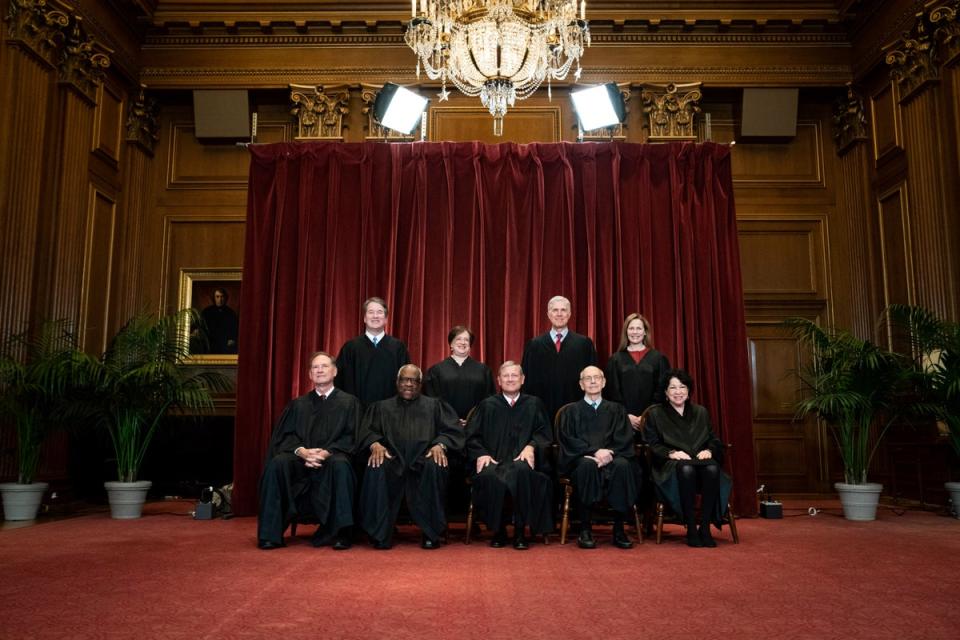US Supreme Court: Who’s who and the ideologies of the court

The Supreme Court of the United States (SCOTUS), has overturned almost 50 years of reproductive rights, in their overturning of Roe v Wade.
Many states are already banning or restricting abortions, while others are set to introduce new rules within the month.
The Supreme Court’s decision was made possible by an emboldened right side of the court, including three appointees of Donald Trump.
So who are the Supreme Court Justices and what are their political leanings?
John G Roberts, Jr., Chief Justice of the United States
The 17th Chief Justice John G Roberts was appointed by George W Bush in 2005, as most senior member of the Supreme Court of the United States.
Chief Justice Roberts, 67, has an unpredictable reputation.
A member of the court’s conservative right-wing, he has been noted to split from the opinion of his conservative peers - and is not officially registered as a Republican voter.
Although he no longer holds the swing vote, in a now-majority conservative panel, the leader found his soft power in majority votes on narrow decisions, like the Affordable Care Act.
Clarence Thomas, Associate Justice
Clarence Thomas was anointed by the first President Bush in 1991 as the second black justice (after Thurgood Marshall).
Surviving a relentless confirmation battle and sexual harassment claims from his former assistant Anita Hill, which a police investigation ruled to be “unfounded” and which Thomas vehemently denied, Thomas has been the longest-serving justice – celebrating 30 years in 2021.
Thomas, known for his stoic approach to verbal debates, has kept his opinion quiet – but predictable nonetheless with an unfailing conservative past.
Despite this sombre face in court, the 73-year-old is “universally adored”, legal analyst Jeffrey Toobin wrote in 2007.
His significant contributions included aiding his conservative colleagues in cases on gun control, campaign finance and religious freedom.
Stephen G. Breyer, Associate Justice
Associate Justice Stephen Breyer announced his retirement in January 2022, after 27 years on the court.
His replacement Justice Kentaji Brown Jackson will be sworn in as the first black woman on the Supreme Court, following his step down at the end of the court’s term – although her liberal-leaning is not expected to sway the majority.
Bill Clinton nominated Breyer, 83, in 1994 after his work on the US Court of Appeals and the Senate Judiciary Committee.
The moderate justice made his mark by satisfying both sides with a sensible approach to the real-life impact of judicial decisions.
Samuel A. Alito, Jr., Associate Justice
Far from an ideologist, Associate Justice Samuel Alito, 72, has bordered conservative and libertarian ideas in his case-by-case approach.
His empathetic style has appeared limited to those he can relate to, with the previously leaked draft opinion supposedly written by Alito, reported by Politico, to strike down Roe v Wade and make abortions illegal in 22 states.
Born in New Jersey, he graduated in law from Princeton University and Yale Law School.
President George W Bush chose Alito to replace Justice Sandra Day O’Connor, the first woman on the SCOTUS, in 2005.
Sonia Sotomayor, Associate Justice
Sonia Sotomayor, 67, is no stranger to difference as only the third woman to hold the Associate Justice position.
Sotomayor preceded her role on the Supreme Court as the youngest judge in the Southern District and the first Hispanic federal judge in New York State.
She was the first Puerto Rican woman to serve as a judge in a US federal court.
Nominated by President Obama in 2009, Sotomayor found fame with her ruling that “saved” Major League Baseball, in a decision to remove the salary cap and end a strike before the season began.
The sharp justice has openly voiced her liberal views in the six years in her seat.
Elena Kagan, Associate Justice
Elena Kagan, 62, sits on the court’s liberal wing as the 100th Associate Justice, nominated in 2012 by President Obama.
After her Harvard Law School education, Kagan boosted her credentials by clerking for Thurgood Marshall.
Kagan provided a new perspective with her lack of judicial experience and as the youngest sitting justice at the time.
Kagan sat with Ginsburg and Sotomayor, making three female justices on the court for the first time in history.
The apparently avid Marvel fan, as proven by her Spiderman references in Kimble v Marvel Entertainment, sits on the liberal wing – having evolved her opinion on same-sex marriage since her confirmation.
Neil M. Gorsuch, Associate Justice
Constitutional originalist Meil Gorsuch, 54, took his seat in 2017.
His approach to legal texts is taken from the literal meaning of words, as opposed to the intention of the author or the context.
Nominated by Donald Trump, his advocacy for religious tolerance has stood strong, protecting popular and “unpopular religious beliefs”, he said in Burwell v Hobby Lobby, where a Christian couple refused to sell drugs or devices that could take a life.
Brett M. Kavanaugh, Associate Justice 57
Brett Kavanaugh, after his searing confirmation dominated by the objection of sexual harassment and partisanship, came to court in 2018.
Kavanaugh’s, 57, first crack at the US Court of Appeals in 2003 was blocked by Democratic senators who accused him of being overly partisan.
In 2006, Bush nominated him again and he was confirmed by a 57-36 vote.
Judge Kavanaugh sat on the DC circuit with a conservative record until his nomination by President Trump in 2018.
Amy Coney Barrett, Associate Justice
Anointed by Donald Trump in October 2020, Amy Coney Barrett formed the final member of the six-three conservative advantage as the most recent seat.
Since the 50-year-old’s arrival, Chief Justice Roberts has no longer been needed to achieve the five-vote majority.
Barrett replaced the infamous Justice Ruth Bader Ginsburg, after the latter’s death from pancreatic cancer.

 Yahoo Sport
Yahoo Sport 





































